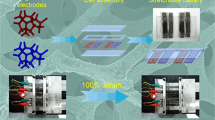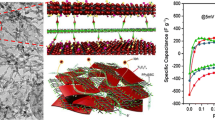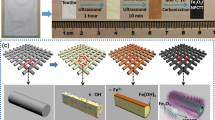Abstract
Integrating functional nanomaterials on nonplanar organisms has emerged as a rising technology, while significant mismatch would cause interface failure and poor durability. Herein, we demonstrate a facile strategy to assemble crystalline catecholate frameworks with honeycomb lattice on seaweed-derived polysaccharide microfibers, which is expected to form biomimetic connections and maintain durable stability. By physiological coagulation, well-aligned ZnO nanoarrays are tightly attached on alginate fibers, which is fractionally adopted as sacrifice for heteroepitaxial growth of zinc-catecholate frameworks (Zn3(HHTP)2). Benefiting from amplification effect of in-situ formed heterojunctions, promoted interfacial charge transfer is achieved, which allows for fabricating broadband photodetectors. Combined with high porosity for gas adsorption, the heteroepitaxial catecholate framework further enables its use as highly selective ppb-level triethylamine sensors. This work provides a promising strategy for heteroepitaxial growth of catecholate frameworks on organo-substrates and opens new applications in wearable sensor platform based on comfortable biofibers.

Similar content being viewed by others
References
Li, B.; Wen, H. M.; Cui, Y. J.; Zhou, W.; Qian, G. D.; Chen, B. L. Emerging multifunctional metal-organic framework materials. Adv. Mater. 2016, 28, 8819–8860.
Lien, M. B.; Liu, C. H.; Chun, I. Y.; Ravishankar, S.; Nien, H.; Zhou, M. M.; Fessler, J. A.; Zhong, Z. H.; Norris, T. B. Ranging and light field imaging with transparent photodetectors. Nat. Photonics 2020, 14, 143–148.
Jin, S. How to effectively utilize MOFs for electrocatalysis. ACS Energy Lett. 2019, 4, 1443–1445.
Kitao, T.; Zhang, Y. Y.; Kitagawa, S.; Wang, B.; Uemura, T. Hybridization of MOFs and polymers. Chem. Soc. Rev. 2011, 46, 3108–3133.
Day, R. W.; Bediako, D. K.; Rezaee, M.; Parent, L. R.; Skorupskii, G.; Arguilla, M. Q.; Hendon, C. H.; Stassen, I.; Gianneschi, N. C.; Kim, P. et al. Single crystals of electrically conductive two-dimensional metal-organic frameworks: Structural and electrical transport properties. ACS Cent. Sci. 2019, 5, 1959–1964.
de Lourdes Gonzalez-Juarez, M.; Flores, E.; Martin-Gonzalez, M.; Nandhakumar, I.; Bradshaw, D. Electrochemical deposition and thermoelectric characterisation of a semiconducting 2-D metal-organic framework thin film. J. Mater. Chem. A 2020, 8, 13197–13206.
Wang, W. W.; Xu, B. L.; Pan, X. T.; Zhang, J. F.; Liu, H. Y. Solvent-dependent adsorption-driven mechanism for MOFs-based yolk-shell nanostructures. Angew. Chem., Int. Ed. 2021, 60, 7802–7808.
Du, X.; Zhang, J. N.; Wang, H. L.; Huang, Z. H.; Guo, A. K.; Zhao, L.; Niu, Y.; Li, X. L.; Wu, B.; Liu, Y. Q. Solid-solid interface growth of conductive metal-organic framework nanowire arrays and their supercapacitor application. Mater. Chem. Front. 2020, 4, 243–251.
Hou, J. M.; Hong, X. L.; Zhou, S.; Wei, Y. Y.; Wang, H. H. Solvent-free route for metal-organic framework membranes growth aiming for efficient gas separation. AIChE J. 2019, 65, 712–722.
Lee, D. T.; Zhao, J. J.; Oldham, C. J.; Peterson, G. W.; Parsons, G. N. UiO-66-NH2 metal-organic framework (MOF) nucleation on TiO2, ZnO, and Al2O3 atomic layer deposition-treated polymer fibers: Role of metal oxide on MOF growth and catalytic hydrolysis of chemical warfare agent simulants. ACS Appl. Mater. Interfaces 2017, 9, 44847–44855.
Sun, L.; Campbell, M. G.; Dincă, M. Electrically conductive porous metal-organic frameworks. Angew. Chem., Int. Ed. 2016, 55, 3566–3579.
Gao, Z. Q.; Wang, C. Y.; Li, J. J.; Zhu, Y. T.; Zhang, Z. C.; Hu, W. P. Conductive metal-organic frameworks for electrocatalysis: Achievements, challenges, and opportunities. Acta Phys. Chim. Sin. 2021, 37, 2010025.
Xie, L. S.; Skorupskii, G.; Dincă, M. Electrically conductive metal-organic frameworks. Chem. Rev. 2020, 120, 8536–8580.
Bhardwaj, S. K.; Bhardwaj, N.; Kaur, R.; Mehta, J.; Sharma, A. L.; Kim, K. H.; Deep, A. An overview of different strategies to introduce conductivity in metal-organic frameworks and miscellaneous applications thereof. J. Mater. Chem. A 2018, 6, 14992–15009.
Johnson, E. M.; Ilic, S.; Morris, A. J. Design strategies for enhanced conductivity in metal-organic frameworks. ACS Cent. Sci. 2021, 7, 445–453.
Mähringer, A.; Döblinger, M.; Hennemann, M.; Gruber, C.; Fehn, D.; Scheurle, P. I.; Hosseini, P.; Santourian, I.; Schirmacher, A.; Rotter, J. M. et al. An electrically conducting three-dimensional iron-catecholate porous framework. Angew. Chem., Int. Ed. 2021, 60, 18065–18072.
Chen, S.; Dai, J.; Zeng, X. C. Metal-organic Kagome lattices M3(2, 3, 6, 7, 10, 11-hexaiminotriphenylene)2 (M = Ni and Cu): From semiconducting to metallic by metal substitution. Phys. Chem. Chem. Phys. 2015, 17, 5954–5958.
Yang, L. M.; He, X.; Dincă, M. Triphenylene-bridged trinuclear complexes of Cu: Models for spin interactions in two-dimensional electrically conductive metal-organic frameworks. J. Am. Chem. Soc. 2019, 141, 10475–10480.
Li, W. H.; Ding, K.; Tian, H. R.; Yao, M. S.; Nath, B.; Deng, W. H.; Wang, Y. B.; Xu, G. Conductive metal-organic framework nanowire array electrodes for high-performance solid-state supercapacitors. Adv. Funct. Mater. 2017, 27, 1702067.
Stavila, V.; Schneider, C.; Mowry, C.; Zeitler, T. R.; Greathouse, J. A.; Robinson, A. L.; Denning, J. M.; Volponi, J.; Leong, K.; Quan, W. et al. Thin film growth of nbo MOFs and their integration with electroacoustic devices. Adv. Funct. Mater. 2016, 26, 1699–1707.
Liu, Y. X.; Wei, Y. N.; Liu, M. H.; Bai, Y. C.; Wang, X. Y.; Shang, S. C.; Du, C. S.; Gao, W. Q.; Chen, J. Y.; Liu, Y. Q. Face-to-face growth of wafer-scale 2D semiconducting mof films on dielectric substrates. Adv. Mater. 2021, 33, e2007741.
Ma, Q. L.; Yin, P. F.; Zhao, M. T.; Luo, Z. Y.; Huang, Y.; He, Q. Y.; Yu, Y. F.; Liu, Z. Q.; Hu, Z. N.; Chen, B. et al. MOF-based hierarchical structures for solar-thermal clean water production. Adv. Mater. 2019, 31, e1808249.
Yao, M. S.; Xiu, J. W.; Huang, Q. Q.; Li, W. H.; Wu, W. W.; Wu, A. Q.; Cao, L. A.; Deng, W. H.; Wang, G. E.; Xu, G. Van der Waals heterostructured MOF-on-MOF thin films: Cascading functionality to realize advanced chemiresistive sensing. Angew. Chem., Int. Ed. 2019, 58, 14915–14919.
Yang, Q.; Liu, Y.; Pan, C. F.; Chen, J.; Wen, X. N.; Wang, Z. L. Largely enhanced efficiency in ZnO nanowire/p-polymer hybridized inorganic/organic ultraviolet light-emitting diode by piezo-phototronic effect. Nano Lett. 2013, 13, 607–613.
Yilmaz, G.; Yam, K. M.; Zhang, C.; Fan, H. J.; Ho, G. W. In situ transformation of MOFs into layered double hydroxide embedded metal sulfides for improved electrocatalytic and supercapacitive performance. Adv. Mater. 2017, 29, 1606814.
Wang, P. Z.; Liu, K.; Wang, X. X.; Meng, Z. T.; Xin, Z. F.; Cui, C. C.; Quan, F. Y.; Zhang, K. W.; Xia, Y. Z. Interface engineering of calligraphic ink mediated conformal polymer fibers for advanced flexible supercapacitors. J. Mater. Chem. A 2022, 10, 15776.
Wan, F. Q.; Ping, H.; Wang, W. X.; Zou, Z. Y.; Xie, H.; Su, B. L.; Liu, D. B.; Fu, Z. Y. Hydroxyapatite-reinforced alginate fibers with bioinspired dually aligned architectures. Carbohydr. Polym. 2021, 267, 118167.
Wang, P. Z.; Du, X. X.; Wang, X. J.; Zhang, K. W.; Sun, J. H.; Chen, Z.; Xia, Y. Z. Integrated fiber electrodes based on marine polysaccharide for ultrahigh-energy-density flexible supercapacitors. J. Power Sources 2021, 506, 230130.
Hu, W. W.; Lin, Y. T. Alginate/polycaprolactone composite fibers as multifunctional wound dressings. Carbohydr. Polym. 2022, 289, 119440.
Hoang, D. V.; Vu, N. H.; Do, N. T.; Pham, A. T. T.; Nguyen, T. H.; Kuo, J. L.; Phan, T. B.; Tran, V. C. Hydrogen roles approaching ideal electrical and optical properties for undoped and Al doped ZnO thin films. J. Materiomics 2022, 8, 123–135.
Peng, Z.; Abbas, S. C.; Lv, J. Q.; Yang, R.; Wu, M. X.; Wang, Y. B. Mixed-metal organic framework-coated ZnO nanowires array for efficient photoelectrochemical water oxidation. Int. J. Hydrogen Energy 2019, 44, 2446.
Hmadeh, M.; Lu, Z.; Liu, Z.; Gándara, F.; Furukawa, H.; Wan, S.; Augustyn, V.; Chang, R.; Liao, L.; Zhou, F. et al. New porous crystals of extended metal-catecholates. Chem. Mater. 2012, 24, 3511–3513.
Yao, M. S.; Lv, X. J.; Fu, Z. H.; Li, W. H.; Deng, W. H.; Wu, G. D.; Xu, G. Layer-by-layer assembled conductive metal-organic framework nanofilms for room-temperature chemiresistive sensing. Angew. Chem., Int. Ed. 2017, 56, 16510–16514.
Bai, S. L.; Zhang, K. W.; Luo, R. X.; Li, D. Q.; Chen, A. F.; Liu, C. C. Sonochemical synthesis of hierarchically assembled tungsten oxides with excellent NO2-sensing properties. Mater. Lett. 2013, 111, 32–34.
Rubio-Giménez, V.; Almora-Barrios, N.; Escorcia-Ariza, G.; Galbiati, M.; Sessolo, M.; Tatay, S.; Martí-Gastaldo, C. Origin of the chemiresistive response of ultrathin films of conductive metal-organic frameworks. Angew. Chem., Int. Ed. 2018, 57, 15086–15090.
Du, X. X.; Tian, W. L.; Pan, J. H.; Hui, B.; Sun, J. H.; Zhang, K. W.; Xia, Y. Z. Piezo-phototronic effect promoted carrier separation in coaxial p-n junctions for self-powered photodetector. Nano Energy 2022, 92, 106694.
Cao, L. A.; Yao, M. S.; Jiang, H. J.; Kitagawa, S.; Ye, X. L.; Li, W. H.; Xu, G. A highly oriented conductive MOF thin film-based Schottky diode for self-powered light and gas detection. J. Mater. Chem. A 2020, 8, 9085–9090.
Ko, M.; Mendecki, L.; Eagleton, A. M.; Durbin, C. G.; Stolz, R. M.; Meng, Z.; Mirica, K. A. Employing conductive metal-organic frameworks for voltammetric detection of neurochemicals. J. Am. Chem. Soc. 2020, 142, 11717–11733.
Wu, G.; Sun, S. Y.; Zhu, X. L.; Ma, Z. Y.; Zhang, Y. M.; Bao, N. Z. Microfluidic fabrication of hierarchical-ordered ZIF-L(Zn)@Ti3C2Tx core-sheath fibers for high-performance asymmetric supercapacitors. Angew. Chem., Int. Ed. 2022, 61, e202115559.
Jin, Z. W.; Wang, J. Z. PIN architecture for ultrasensitive organic thin film photoconductors. Sci. Rep. 2014, 4, 5331.
Jo, Y. M.; Lim, K.; Yoon, J. W.; Jo, Y. K.; Moon, Y. K.; Jang, H. W.; Lee, J. H. Visible-light-activated type II heterojunction in Cu3(hexahydroxytriphenylene)2/Fe2O3 hybrids for reversible NO2 sensing: Critical role of π-π* transition. ACS Cent. Sci. 2021, 7, 1176–1182.
Chuang, C. H. M.; Brown, P. R.; Bulović, V.; Bawendi, M. G. Improved performance and stability in quantum dot solar cells through band alignment engineering. Nat. Mater. 2014, 13, 796–801.
Du, X. X.; Tian, W. L.; Zhang, Z. Q.; Hui, B.; Pan, J. H.; Sun, J. H.; Zhang, K. W. Defect promoted photothermoelectric effect in densely aligned ZnO nanorod arrays for self-powered position-sensitive photodetection. J. Materiomics 2022, 8, 693–701.
Zhang, M. X.; Zhao, Z. H.; Hui, B.; Sun, J. H.; Sun, J. X.; Tian, W. L.; Zhang, Z. Q.; Zhang, K. W.; Xia, Y. Z. Carbonized polymer dots activated hierarchical tungsten oxide for efficient and stable triethylamine sensor. J. Hazard. Mater. 2021, 416, 126161.
Bai, S. L.; Han, J. Y.; Han, N.; Zhang, K. W.; Sun, J. H.; Sun, L. X.; Luo, R. X.; Li, D. Q.; Chen, A. F. An α-Fe2O3/NiO p-n hierarchical heterojunction for the sensitive detection of triethylamine. Inorg. Chem. Front. 2020, 7, 1532–1539.
Bai, S. L.; Zuo, Y.; Zhang, K. W.; Zhao, Y. Y.; Luo, R. X.; Li, D. Q.; Chen, A. F. WO3-ZnFe2O4 heterojunction and rGO decoration synergistically improve the sensing performance of triethylamine. Sens. Actuators B 2021, 347, 130619.
Hu, Q.; He, J. Q.; Chang, J. Y.; Gao, J. M.; Huang, J. H.; Feng, L. Needle-shaped WO3 nanorods for triethylamine gas sensing. ACS Appl. Nano Mater. 2020, 3, 9046–9054.
Li, Q. Q.; Han, N.; Zhang, K. W.; Bai, S. L.; Guo, J.; Luo, R. X.; Li, D. Q.; Chen, A. F. Novel p-n heterojunction of BiVO4/Cu2O decorated with rGO for low concentration of NO2 detection. Sens. Actuators B 2020, 320, 128284.
Yuan, H. Y.; Li, N. X.; Fan, W. D.; Cai, H.; Zhao, D. Metal-organic framework based gas sensors. Adv. Sci. 2022, 9, 2104374.
Acknowledgments
This work was supported by the National Natural Science Foundation of China (No. 51973099), Taishan Scholar Program of Shandong Province (Nos. tsqn201812055 and tspd20181208), and the State Key Laboratory of Bio-Fibers and Eco-Textiles (Qingdao University) (Nos. ZKT04 and GZRC202007).
Author information
Authors and Affiliations
Corresponding authors
Electronic Supplementary Material
Rights and permissions
About this article
Cite this article
Liu, K., Zhang, M., Du, X. et al. Zinc-catecholete frameworks biomimetically grown on marine polysaccharide microfibers for soft electronic platform. Nano Res. 16, 1296–1303 (2023). https://doi.org/10.1007/s12274-022-4798-0
Received:
Revised:
Accepted:
Published:
Issue Date:
DOI: https://doi.org/10.1007/s12274-022-4798-0




